warning DODGE DURANGO 2022 Vehicle Warranty
[x] Cancel search | Manufacturer: DODGE, Model Year: 2022, Model line: DURANGO, Model: DODGE DURANGO 2022Pages: 200, PDF Size: 6.72 MB
Page 21 of 200

TIRE WARRANTY
20
Check Your Tires For Damage
Frequent (at least monthly) inspection of your tires for signs of damage, uneven tread
we
ar and their general condition is important for safety. Impacts, penetrations, cracks,
knots, bulges or air loss always require tire removal and expert inspection.
NOTE:
All tire warranties are made by the tire manufacturer. Tires are not covered under your
Ne
w Vehicle Limited Warranty.
WARNING!
Death, serious injury and/or property damage may result from tire failure due to tire
damage and/or improper tire maintenance.
• A ll tires (including spare) should be inspected regularly by a qualified technician for
s
igns of wear, and signs of damage, such as puncture, impact, improper mainte -
nance, underinflation or overinflation and overloading.
• O nly qualified persons should repair tires. See US Tire Manufacturers Association
(
USTMA) established repair procedures at www.USTires.org for information on
proper repair procedures.
• O nly specially trained persons should mount tires.
Page 22 of 200

21
BFGOODRICH® TIRES
ABOUT THIS WARRANTY
As the original purchaser of a BFGoodrich® brand passenger or light truck tire, you are
covered by all the benefits and conditions (subject to the maintenance
recommendations and safety warnings) contained in this booklet. To ensure your
understanding of and compliance with the terms and conditions of this warranty, please
read it carefully. It is essential that you also read and understand the safety and
maintenance recommendations for tires contained in this booklet.
WHAT IS COVERED AND FOR HOW LONG
Passenger and Light Truck Tires
BFGoodrich® brand passenger and light truck tires, used in normal service on the
veh
icle on which they were originally fitted and in accordance with the maintenance
recommendations and safety warnings contained in the attached Owner’s Manual, are
covered by this warranty against defects in workmanship and materials for the life of the
original usable tread, or six years from the date of purchase, whichever occurs first. At
that time, all warranties, express or implied, expire. The life of the original usable tread
is the original tread down to the level of the tread wear indicators - 2/32nds of an inch
(1.6 mm) of tread remaining. Date of purchase is documented by new vehicle
reg
istration or tire sales invoice. If no proof of purchase is available, coverage will be
based on the date of manufacture. Replacement will be made in accordance with the
terms and conditions described under “How Replacement Charges are Calculated”.
NOTE:
Your vehicle manufacturer may provide additional tire warranty coverage over and above
wh a
t is provided by BFGoodrich®. Consult your vehicle Owner’s Manual for further infor -
mation.
WHAT IS NOT COVERED
Tires Which Become Unserviceable Due To:
• Road hazard injury (e.g., a cut, snag, bruise, impact damage or puncture)
• In
correct mounting of the tire, tire/wheel imbalance or improper repair
• Mi
sapplication, improper maintenance, racing, underinflation, overinflation or other
a b
use
• Operation without a properly functioning low pressure warning system, for Comp T/A® ZR
SSS tires
• Uneven or rapid wear which is caused by mechanical irregularity in the vehicle such as wh
eel misalignment, a measured tread difference of 2/32 of an inch (1.6 mm) or
mo r
e across the tread on the same tire
• Accident, fire, chemical corrosion, tire alteration or vandalism
• Fl
at spotting caused by improper storage or brake lock
Page 24 of 200

BFGOODRICH® TIRES
23
SAFETY MAINTENANCE INFORMATION
Read your Tire Owner’s Manual, the information on the sidewall of your tires, your vehicle
Owner’s Manual and vehicle tire information placard for essential safety and
maintenance information.
When service is required:
1. C ontact a participating BFGoodrich® tire retailer listed in your yellow pages.
2
. I f additional assistance is needed in locating a BFGoodrich® retailer, please call or
w
rite to the Consumer Care Department listed in this book.
You should have complete confidence in your new BFGoodrich® tires. Still it is important
t o
register your tires in the event that we need to contact you. For online tire registration,
visit https://www.tireregistration.com/ .
TIRE DISABLEMENT SAFETY WARNING
Any tire may fail as a result of an improperly repaired puncture, impact damage, improper
inflation, overloading or other conditions resulting from use or misuse. Tire failures, such
as a rapid air loss or a tread and belt detachment, may increase risk of injury or death
and/or property damage. To reduce the risk of a tire failure, BFGoodrich® recommends
you thoroughly read and follow the recommendations in this BFGoodrich® Limited
Warranty/Owner’s Manual, the vehicle Owner’s Manual, tire placard information, and tire
sidewall information regarding safety warnings, proper tire use and maintenance.
CONTROLLABILITY
CONTROLLING A VEHICLE WHEN A TIRE FAILURE OCCURS
If a tire failure occurs, you may hear a loud noise, feel a vibration, and/or the vehicle may
pu
ll toward the side of the failed tire. If possible, step on the accelerator momentarily to
maintain forward momentum and ensure vehicle control.
It is important that you DO NOT BRAKE OR ABRUPTLY TURN THE STEERING WHEEL.
Slowly remove your foot from the accelerator and hold the steering wheel firmly while
s t
eering to remain in your lane. Once the vehicle has slowed and is fully under control,
apply the brakes gently; safely pull over to the shoulder and come to a stop. Inspect the
tires. If one or more tires look flat or low, show detachment or other damage, remove tire
assembly and replace it with a properly inflated spare. Bumps or bulges may indicate
detachment within the tire body and require inspection by a qualified tire technician.
WARNING!
DISREGARDING ANY OF THE SAFETY PRECAUTIONS AND/OR INSTRUCTIONS
CONTAINED IN THIS MANUAL MAY RESULT IN TIRE FAILURE OR EXPLOSION CAUSING
SERIOUS PERSONAL INJURY OR DEATH.
Page 35 of 200

BFGOODRICH® TIRES
34
If you see or suspect any damage to your tires or wheels, contact your local BFGoodrich®
tire retailer, or visit our web site listed below for dealer locations. If further assistance is
required, contact:
Correct tire pressure is very important. Proper inflation pressures may be found in the
ve
hicle Owner’s Manual or on the vehicle tire information placard. Check cold tire
pressures at least once each month. For further technical information on BFGoodrich®
tires, consult a participating BFGoodrich® tire retailer. IN USA
IN CANADA
877-788-8899 888-871-6666
or write:
Michelin North America, Inc.
Attention: Consumer Care Department Post Office Box 19001
Greenville, SC 29602-9001 United States or write:
Michelin North America (Canada), Inc.
2500 Daniel-Johnson Blvd., Suite 500 Laval, QuebecH7T 2P6Canada
or visit:
www.bfgoodrichtires.com or visit:
https://www.bfgoodrich.ca/en/home
WARNING!
For safety and good performance, you must take care of your tires. Follow the safety
information and instructions contained in this Owner’s Manual.
Your Vehicle:
Year Make/Model
Your Tire Size:
Tire Purchase Date:
Recommended
P r
essures: Front
Rear
Page 40 of 200
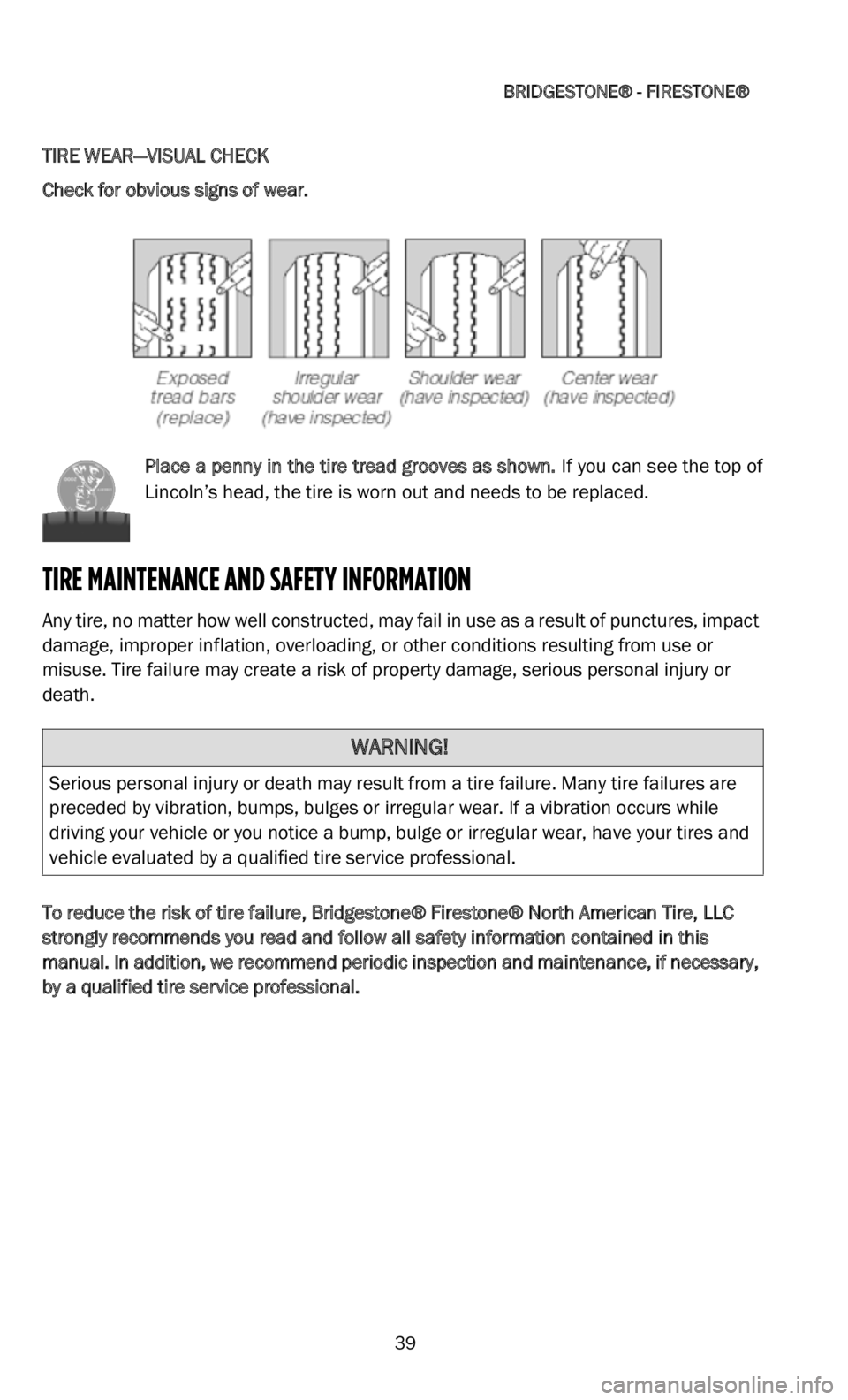
BRIDGESTONE® - FIRESTONE®
39
TIRE WEAR—VISUAL CHECK
Check for obvious signs of wear. Place a penny in the tire tread grooves as shown. I
f you can see the top of
Lincoln’s head, the tire is worn out and needs to be replaced.
TIRE MAINTENANCE AND SAFETY INFORMATION
Any tire, no matter how well constructed, may fail in use as a result of punctures, impact
damage, improper inflation, overloading, or other conditions resulting from use or
misuse. Tire failure may create a risk of property damage, serious personal injury or
death.
To reduce the risk of tire failure, Bridgestone® Firestone® North American Tire, LLC
s t
rongly recommends you read and follow all safety information contained in this
manual. In addition, we recommend periodic inspection and maintenance, if necessary,
by a qualified tire service professional.
WARNING!
Serious personal injury or death may result from a tire failure. Many tire failures are
preceded by vibration, bumps, bulges or irregular wear. If a vibration occurs while
driving your vehicle or you notice a bump, bulge or irregular wear, have your tires and
vehicle evaluated by a qualified tire service professional.
Page 41 of 200
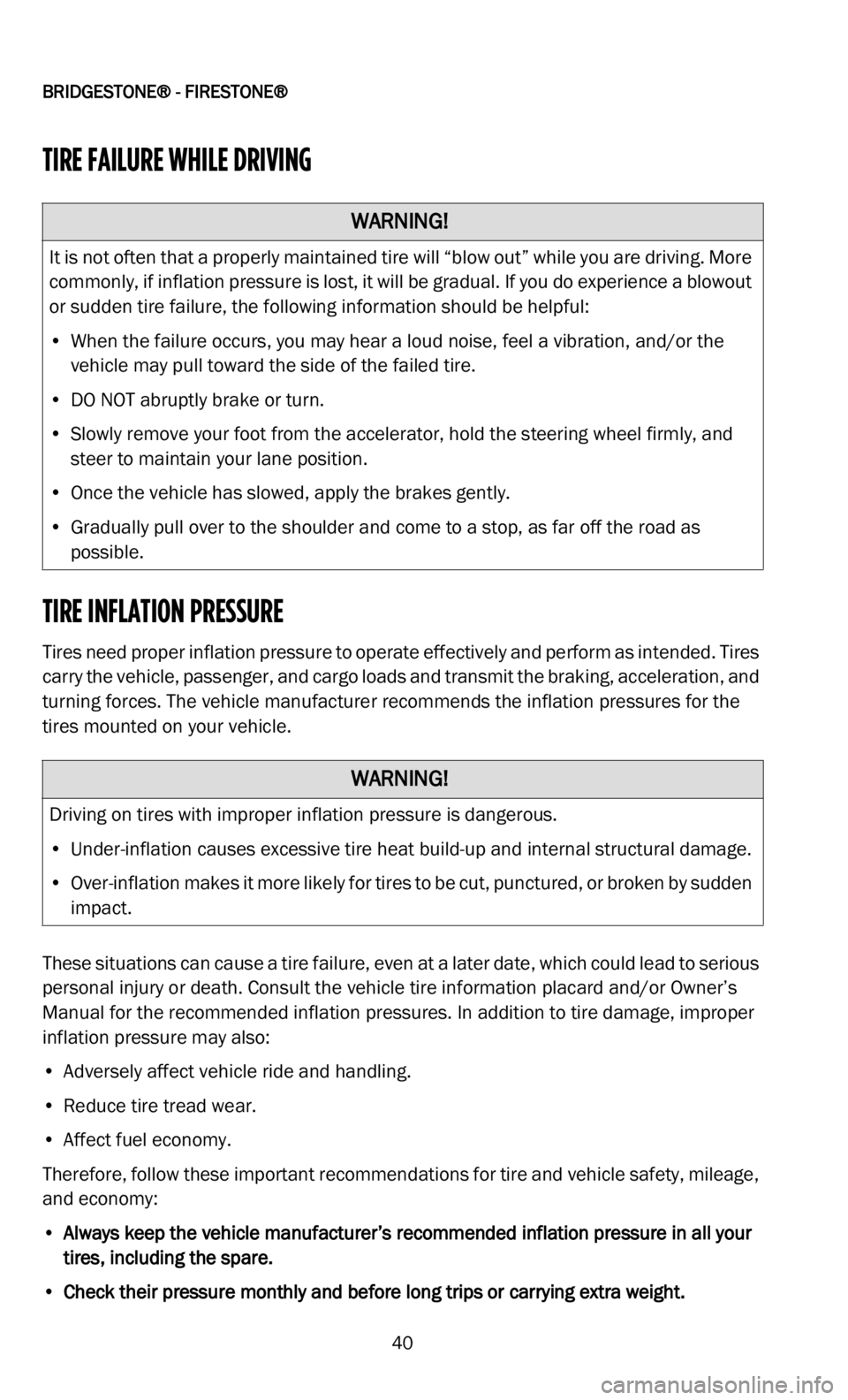
BRIDGESTONE® - FIRESTONE®
40
TIRE FAILURE WHILE DRIVING
TIRE INFLATION PRESSURE
Tires need proper inflation pressure to operate effectively and perform as intended. Tires
carry the vehicle, passenger, and cargo loads and transmit the braking, acceleration, and
turning forces. The vehicle manufacturer recommends the inflation pressures for the
tires mounted on your vehicle.
These situations can cause a tire failure, even at a later date, which could lead to serious
pe
rsonal injury or death. Consult the vehicle tire information placard and/or Owner’s
Manual for the recommended inflation pressures. In addition to tire damage, improper
inflation pressure may also:
• A dversely affect vehicle ride and handling.
•
Reduce tire tread wear.
•
Affect fuel economy.
T
herefore, follow these important recommendations for tire and vehicle safety, mileage,
a n
d economy:
• Always keep the vehicle manufacturer’s recommended inflation pressure in all your
t
ires, including the spare.
• Check their pressure monthly and before long trips or carrying extra weight.
WARNING!
It is not often that a properly maintained tire will “blow out” while you are driving. More
commonly, if inflation pressure is lost, it will be gradual. If you do experience a blowout
or sudden tire failure, the following information should be helpful:
• W hen the failure occurs, you may hear a loud noise, feel a vibration, and/or the
v
ehicle may pull toward the side of the failed tire.
• D O NOT abruptly brake or turn.
•
Slowly remove your foot from the accelerator, hold the steering wheel firmly, and
s
teer to maintain your lane position.
• O nce the vehicle has slowed, apply the brakes gently.
•
Gradually pull over to the shoulder and come to a stop, as far off the road as
p
ossible.
WARNING!
Driving on tires with improper inflation pressure is dangerous.
• U nder-inflation causes excessive tire heat build-up and internal structural damage.
•
Over-inflation makes it more likely for tires to be cut, punctured, or broken by sudden
i
mpact.
Page 43 of 200
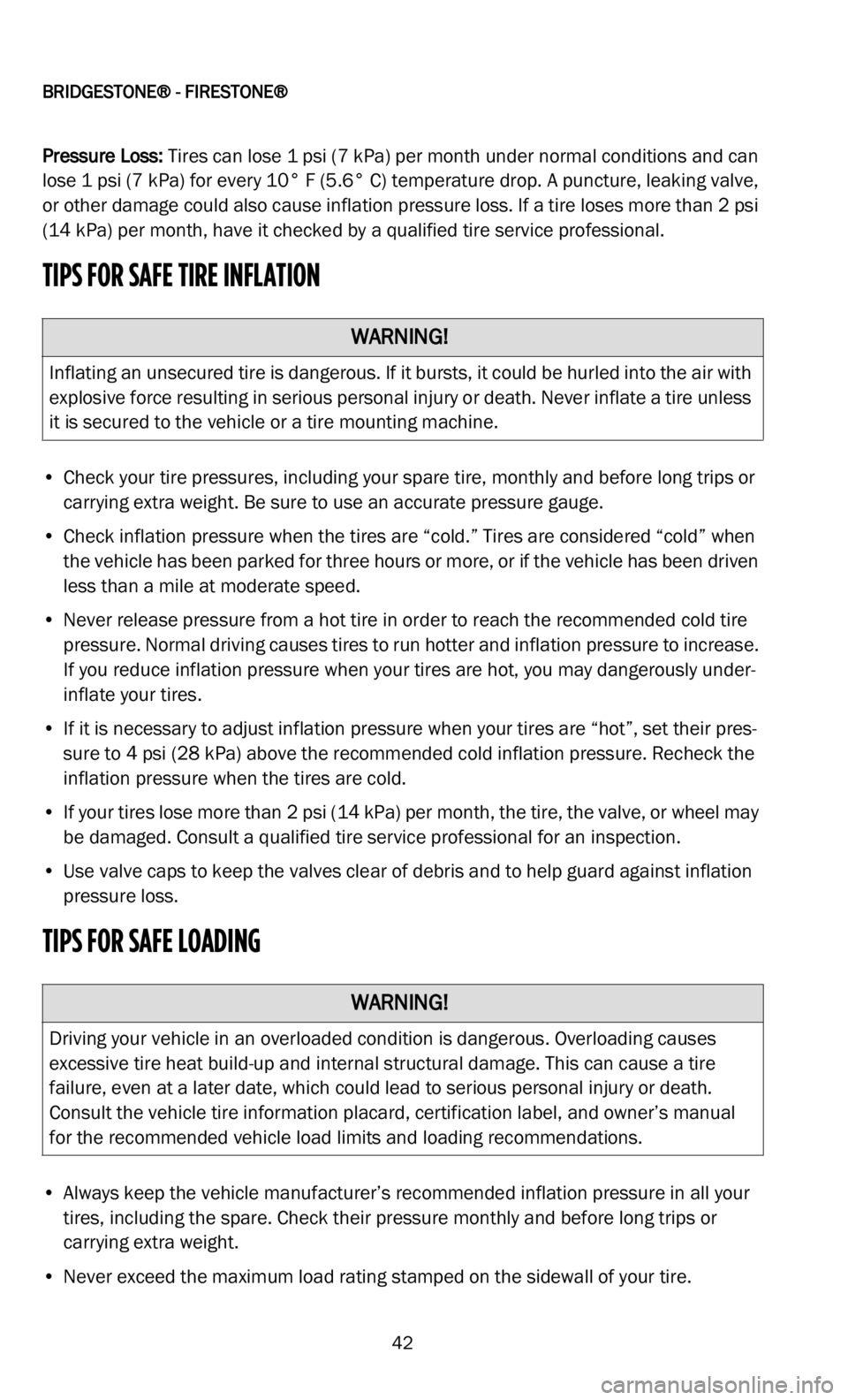
BRIDGESTONE® - FIRESTONE®
42
Pressure Loss: Tires can lose 1 psi (7 kPa) per month under normal conditions and can
lose 1 psi (7 kPa) for every 10° F (5.6° C) temperature drop. A puncture, leaking valve,
or other damage could also cause inflation pressure loss. If a tire loses more than 2 psi
(14 kPa) per month, have it checked by a qualified tire service professional.
TIPS FOR SAFE TIRE INFLATION
• Check your tire pressures, including your spare tire, monthly and before long trips or carrying extra weight. Be sure to use an accurate pressure gauge.
• C heck inflation pressure when the tires are “cold.” Tires are considered “cold” when
t
he vehicle has been parked for three hours or more, or if the vehicle has been driven
less than a mile at moderate speed.
• N ever release pressure from a hot tire in order to reach the recommended cold tire
p
ressure. Normal driving causes tires to run hotter and inflation pressure to increase.
If you reduce inflation pressure when your tires are hot, you may dangerously under -
inflate your tires.
• I f it is necessary to adjust inflation pressure when your tires are “hot”, set their pres -
s
ure to 4 psi (28 kPa) above the recommended cold inflation pressure. Recheck the
i n
flation pressure when the tires are cold.
• I f your tires lose more than 2 psi (14 kPa) per month, the tire, the valve, or wheel may
b
e damaged. Consult a qualified tire service professional for an inspection.
• U se valve caps to keep the valves clear of debris and to help guard against inflation
p
ressure loss.
TIPS FOR SAFE LOADING
• Always keep the vehicle manufacturer’s recommended inflation pressure in all your tires, including the spare. Check their pressure monthly and before long trips or
carrying extra weight.
• N ever exceed the maximum load rating stamped on the sidewall of your tire.
WARNING!
Inflating an unsecured tire is dangerous. If it bursts, it could be hurled into the air with
explosive force resulting in serious personal injury or death. Never inflate a tire unless
it is secured to the vehicle or a tire mounting machine.
WARNING!
Driving your vehicle in an overloaded condition is dangerous. Overloading causes
excessive tire heat build-up and internal structural damage. This can cause a tire
failure, even at a later date, which could lead to serious personal injury or death.
Consult the vehicle tire information placard, certification label, and owner’s manual
for the recommended vehicle load limits and loading recommendations.
Page 44 of 200

BRIDGESTONE® - FIRESTONE®
43
• Never exceed the Gross Vehicle Weight Rating (GVWR) or front/rear Gross Axle Weight Rating (GAWR) of your vehicle.
• C onsult your vehicle Owner’s Manual for load recommendations and special instruc -
t
ions such as for trailer/towing and snow plow installations.
TIRE DAMAGE, INSPECTION AND SERVICE LIFE
Evaluation and maintenance of your tires is important to their performance and the
service they provide to you. Over time and/or through use, the condition of a tire can
change from exposure to everyday road conditions, the environment, damaging events
such as punctures, and other external factors.
You should visually inspect your tires on a regular basis throughout their life, and you
sh
ould have your tires periodically evaluated by a qualified tire service professional when
your vehicle is serviced such as routine maintenance intervals, oil changes, and tire
rotations. In particular, note the following tips for spotting tire damage:
• A fter striking anything unusual in the roadway, have a qualified tire service profes -
s
ional demount the tire and inspect it for damage. A tire may not have visible signs of
d a
mage on the tire surface. Yet, the tire may suddenly fail without warning, a day, a
week, or even months later.
• I nspect your tires for cuts, cracks, splits or bruises in the tread and sidewall areas.
B
umps or bulges may indicate a separation within the tire body. Have your tire
inspected by a qualified tire service professional. It may be necessary to have it
removed from the wheel for a complete inspection.
• I nspect your tires for adequate tread depth. When the tire is worn to the built-in indi -
c
ators at 2/32 of an inch (1.6 mm) or less tread groove depth, or the tire cord or fabric
i s
exposed, the tire is dangerously worn and must be replaced immediately.
• I nspect your tires for uneven wear. Wear on one side of the tread or flat spots in the
t
read may indicate a problem with the tire or vehicle. Consult a qualified tire service
professional.
• I nspect your wheels also. If you have a bent or cracked wheel, it must be replaced.
•
Don’t forget to check the spare tire.
M
ake sure your tires, including the spare tire, continue to be regularly inspected after 5
y e
ars of service to determine if they can continue in service. Even when your tires appear
to be usable from their external appearance or the tread depth may have not reached
the minimum wear out depth, it is recommended that all tires (including spare tires and
“temporary use” spares) more than 10 years old be replaced with new tires.
WARNING!
Driving on damaged tires is dangerous. A damaged tire can suddenly fail causing
serious personal injury or death. Have your tires regularly inspected by a qualified tire
service professional.
Page 45 of 200
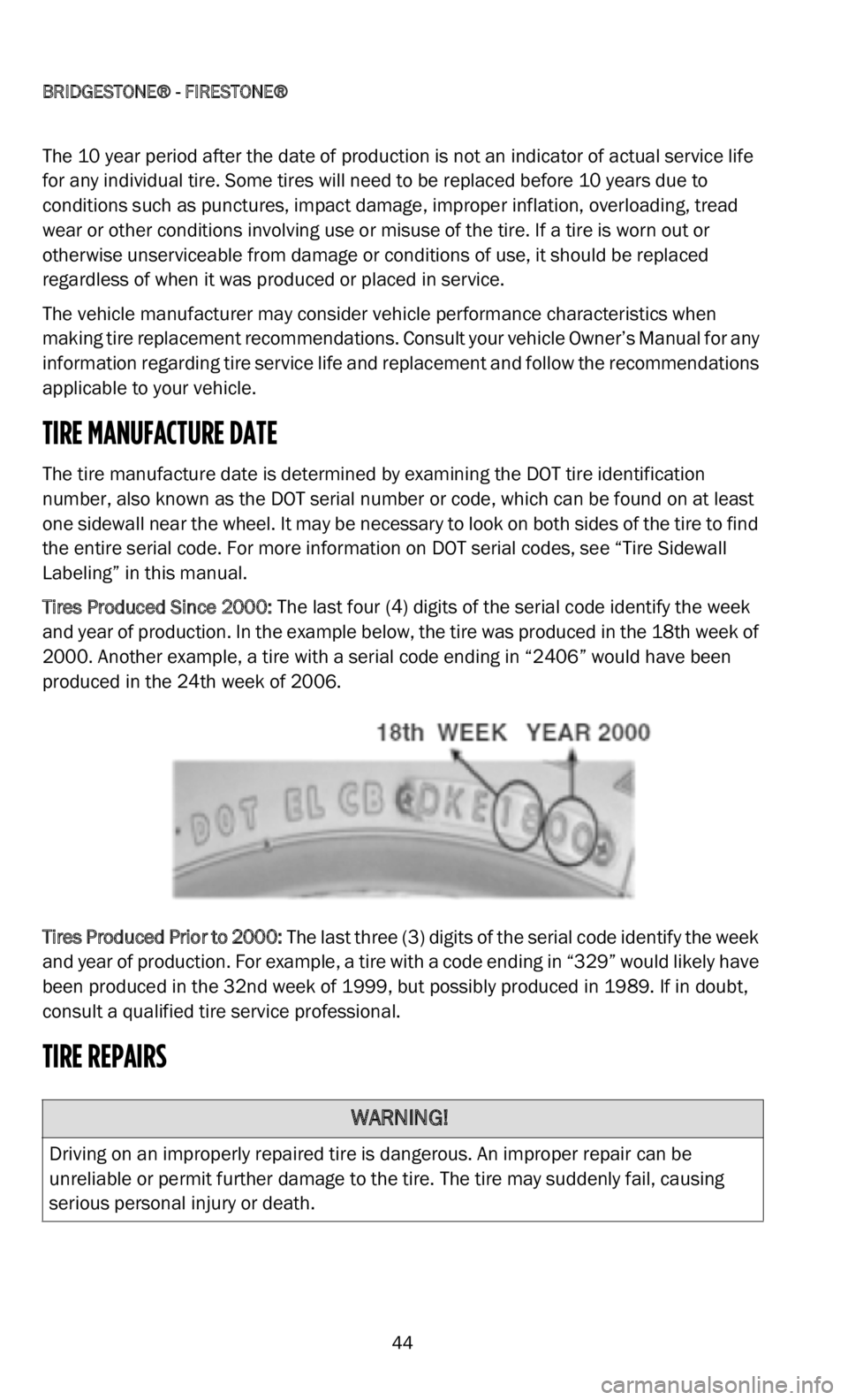
BRIDGESTONE® - FIRESTONE®
44
The 10 year period after the date of production is not an indicator of actual service life
for any individual tire. Some tires will need to be replaced before 10 years due to
conditions such as punctures, impact damage, improper inflation, overloading, tread
wear or other conditions involving use or misuse of the tire. If a tire is worn out or
otherwise unserviceable from damage or conditions of use, it should be replaced
regardless of when it was produced or placed in service.
The vehicle manufacturer may consider vehicle performance characteristics when
ma
king tire replacement recommendations. Consult your vehicle Owner’s Manual for any
information regarding tire service life and replacement and follow the recommendations
applicable to your vehicle.
TIRE MANUFACTURE DATE
The tire manufacture date is determined by examining the DOT tire identification
number, also known as the DOT serial number or code, which can be found on at least
one sidewall near the wheel. It may be necessary to look on both sides of the tire to find
the entire serial code. For more information on DOT serial codes, see “Tire Sidewall
Labeling” in this manual.
Tires Produced Since 2000: T
he last four (4) digits of the serial code identify the week
and year of production. In the example below, the tire was produced in the 18th week of
2000. Another example, a tire with a serial code ending in “2406” would have been
produced in the 24th week of 2006.
Tires Produced Prior to 2000: T
he last three (3) digits of the serial code identify the week
and year of production. For example, a tire with a code ending in “329” would likely have
been produced in the 32nd week of 1999, but possibly produced in 1989. If in doubt,
consult a qualified tire service professional.
TIRE REPAIRS
WARNING!
Driving on an improperly repaired tire is dangerous. An improper repair can be
unreliable or permit further damage to the tire. The tire may suddenly fail, causing
serious personal injury or death.
Page 47 of 200
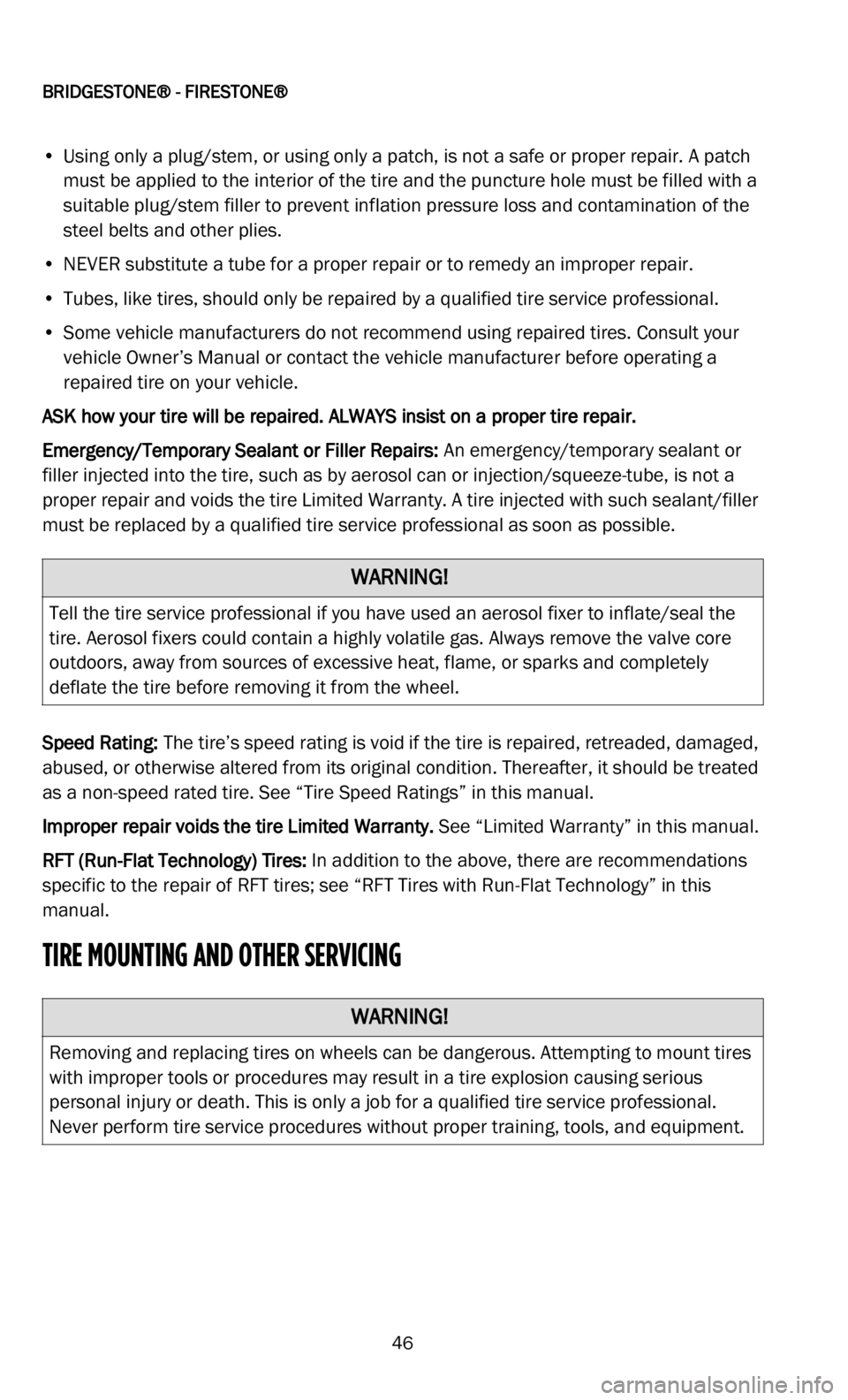
BRIDGESTONE® - FIRESTONE®
46
• Using only a plug/stem, or using only a patch, is not a safe or proper repair. A patch must be applied to the interior of the tire and the puncture hole must be filled with a
suitable plug/stem filler to prevent inflation pressure loss and contamination of the
steel belts and other plies.
• N EVER substitute a tube for a proper repair or to remedy an improper repair.
•
Tubes, like tires, should only be repaired by a qualified tire service professional.
•
Some vehicle manufacturers do not recommend using repaired tires. Consult your
v
ehicle Owner’s Manual or contact the vehicle manufacturer before operating a
repaired tire on your vehicle.
ASK how your tire will be repaired. ALWAYS insist on a proper tire repair.
Emergency/Temporary Sealant or Filler Repairs: A
n emergency/temporary sealant or
filler injected into the tire, such as by aerosol can or injection/squeeze-tube, is not a
proper repair and voids the tire Limited Warranty. A tire injected with such sealant/filler
must be replaced by a qualified tire service professional as soon as possible.
Speed Rating: T
he tire’s speed rating is void if the tire is repaired, retreaded, damaged,
abused, or otherwise altered from its original condition. Thereafter, it should be treated
as a non-speed rated tire. See “Tire Speed Ratings” in this manual.
Improper repair voids the tire Limited Warranty. S
ee “Limited Warranty” in this manual.
RFT (Run-Flat Technology) Tires: I
n addition to the above, there are recommendations
specific to the repair of RFT tires; see “RFT Tires with Run-Flat Technology” in this
manual.
TIRE MOUNTING AND OTHER SERVICING
WARNING!
Tell the tire service professional if you have used an aerosol fixer to inflate/seal the
tire. Aerosol fixers could contain a highly volatile gas. Always remove the valve core
outdoors, away from sources of excessive heat, flame, or sparks and completely
deflate the tire before removing it from the wheel.
WARNING!
Removing and replacing tires on wheels can be dangerous. Attempting to mount tires
with improper tools or procedures may result in a tire explosion causing serious
personal injury or death. This is only a job for a qualified tire service professional.
Never perform tire service procedures without proper training, tools, and equipment.